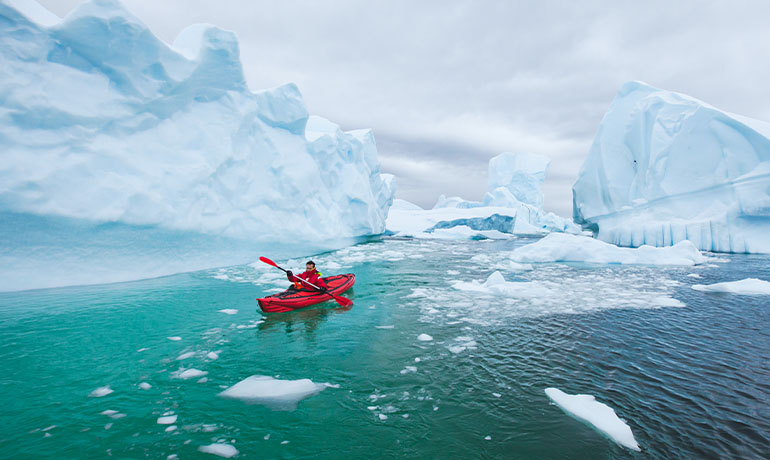Ready for the trip of a lifetime? Antarctica is one of the last places on Earth yet to be explored by humans, and you now have a chance to make landfall on this frozen frontier. With around 50,000 tourists every year, Antarctica is becoming more accessible for tourists excited to embark on the ultimate adventure.
The untouched frozen landscapes prove that nature reigns over all — giant glaciers reaching heights of 50+ stories and beyond, ice sheets covering areas larger than metropolises like Los Angeles, and an abundance of wildlife that live in harmony with the uninhabitable polar regions.
This travel guide provides insight into how you can add the coveted Antarctica stamp to your passport and when you can start planning your journey into the Arctic.
Table of Contents
When Is The Best Time To Visit Antarctica?
Antarctica is often the trip of a lifetime for our Marchay members interested in exploring one of the most remote, untouched regions of the world. So, while it’s still largely uninhabited and with many surprises awaiting you, when is the best time to visit?
The best time to visit Antarctica is during the summer. The season, locally known as the Austral summer, lasts six months, from October to March. It gives a large window for traveling to the continent. There are many things to expect during these months, and you may have preferences based on which month to visit.
Travelers interested in seeing the most dramatic landscapes in Antarctica should consider visiting at the beginning of summer in October and November. The equally-long winter comes to a close, revealing nature’s magical work over the six months of darkness and uninterrupted activity.
Sightseeing wildlife is best done in December and January. This is the peak season when the wildlife is most active with their mating and breeding seasons to see the unique courtship rituals. There is also a bit of history found on the Antarctic coasts, left behind by whalers. These sites are excellent to visit during the late summer when the weather is warmer for outdoor exploration.
When Is The Worst Time To Visit Antarctica?
Lucky for you, the worst time to go on an Antarctica trip is also when it’s inaccessible for tourism. The Antarctica winter lasts six months and has harsh, unexpected weather conditions that prevent any tourist activity on the continent.
Antarctica winters last from April to September. These are the darkest, coldest months in Antarctica, but also are the period largely responsible for its natural beauty. During the winter, the only people in Antarctica are there for research, so you won’t have to worry about missing a thing!
The Antarctica winters are extremely cold, with average temperatures far below the freezing level. It’s when the South Pole faces the opposite direction of the sun, so it has 24-hours of darkness until the sun rises again in October.
In addition to the weather being unfavorable in the winter, getting to Antarctica is also highly unlikely. The winds cause rough water conditions too unsafe for tour providers to cruise the Drake Passage en route to Antarctica. There are also large ice sheets frozen on the water surface that make it nearly impossible to navigate the waterways.
Winter isn’t a time when you would want to visit Antarctica and is a time when even many wildlife species tend to avoid spending time on the continent.
Visiting Antarctica In The Spring
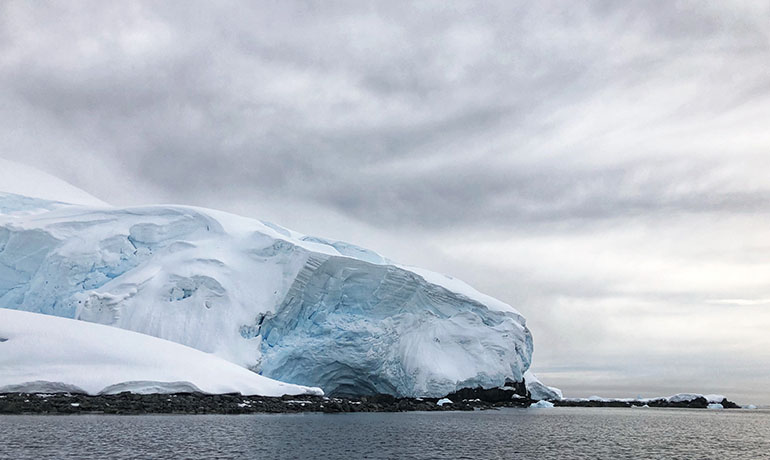
The Spring months of October and November kick off the cruise season in Antarctica! With the sea waters calming and the weather becoming more favorable, this season is when visitors can finally begin returning to the white wilderness. For the continent of Antarctica, springtime is considered the beginning of the summer.
Visiting Antarctica during the Spring lets you experience the continent’s most pristine conditions. Finally, after months of human inactivity and extreme weather conditions, you’ll arrive at a setting of dramatic landscapes. Frozen white glaciers tower at their highest, the frozen desert still has a fresh layer of snow, and the sea ice that Antarctica cruise ships cut through upon arrival.
Average weather during the spring ranges from freezing temperatures of 32 ºF to a mild 50ºF. Also, it’s the first time in months when many places on the continent receive sunlight after a 24-hour nighttime sky in the winter.
Not only do tourists return to Antarctica, but wildlife also migrates back to the continent. various types of seals, including fur seals and leopard seals begin their mating seasons. In addition, tons of seabirds, like the albatross, can be seen soaring overhead, and you’ll begin to see whales returning to the arctic waters to feed on the abundance of krill.
Visiting Antarctica In The Summer
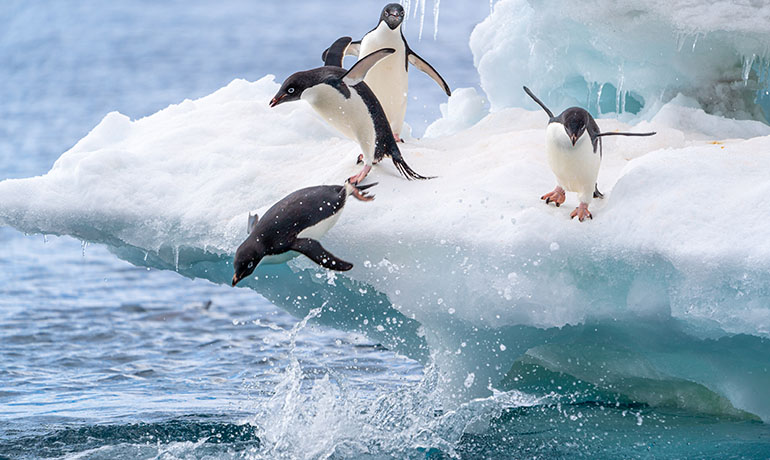
The summer season in Antarctica is the most popular time to visit the continent. For the southern hemisphere, the summer months are January to March, although, in Antarctica, the summer is defined as October to March. Visiting this frozen tundra will give new meaning to summer vacation, but it will undoubtedly be an unforgettable experience.
Did you know that Antarctica gets 24 hours of daylight during the summer? Known as ‘Antarctic Day,’ this time of year is when the region below the polar circle directly faces the sun. The sunrise takes two months to finally reach its peak for the season. However, the heat from the sun helps melt the ice formed over the winter and makes the coastal regions of the continent easier to navigate for ships.
The Antarctica summer has average temperatures in the low 40s. The warmest month to visit Antarctica is in January. The relatively warm conditions make it ideal for visitors to spend time exploring the arctic landscape and sightseeing the local wildlife.
Wildlife is most active during the summer. With the mating season over, the coasts are lined with penguins and their chicks hatching alongside elephant seals and their seal pups. You can see phenomena like mothers nursing the young or waddling towards the coast for their first swim. The summer season is also when you’ll see an abundance of whale pods.
Visiting Antarctica In The Fall
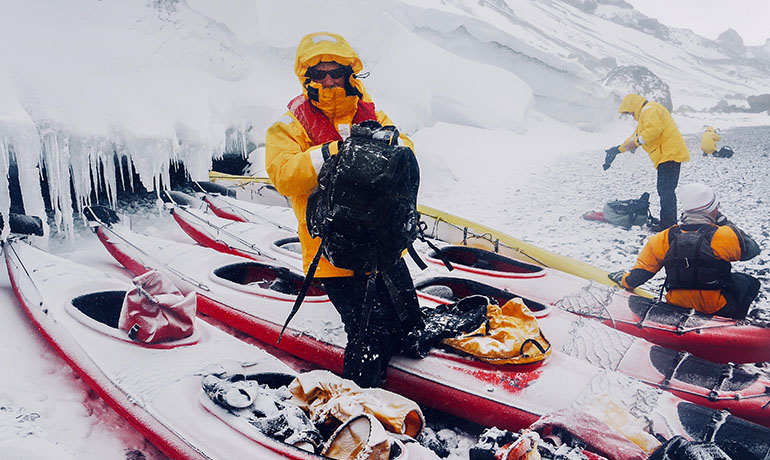
The fall months in the southern hemisphere between April and June are the start of Antarctica’s six-month-long winter season. Unfortunately, visiting Antarctica during these months is not possible due to the temperatures and water conditions.
The popular Drake Passage route when traveling to Antarctica has unpleasant waters during the fall. The rough waters make it unsafe for visitors traveling to Antarctica. But the water conditions aren’t the only thing that makes fall travel to Antarctica unlikely.
Fall enters the ‘Midnight Sun’ period in Antarctica. Most of the continent experiences 24-hours of nighttime after the final sunsets in March and doesn’t reappear until October. With the dark skies comes freezing temperatures that can average between 5°F to -22°F.
A select few still inhabit Antarctica during this time of year. It has a population of approximately 10,000 people, namely scientists and researchers studying the vastly unexplored continent.
Visiting Antarctica In The Winter
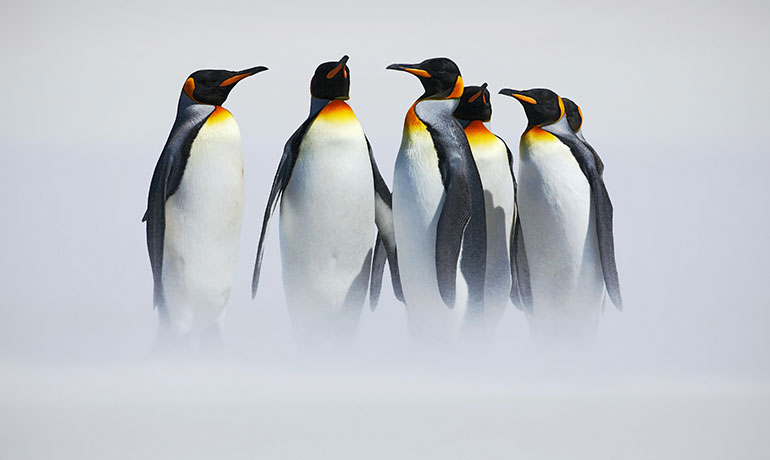
Wintertime is what most people imagine when thinking about Antarctica. But, unfortunately, travel is not available to the continent during this season — and it’s when you’ll least want to visit. Winter in the southern hemisphere occurs from July to September. However, the Antarctica winter is more extensive, starting at the end of March.
The ‘Midnight Sun’ lasts the entire six-month winter. It gives plenty of time for the landscape to freeze over, and there are also exaggerated winds blowing across the continent. As a result, the weather conditions are harsh, even for wildlife that leaves the continent to warmer waters and temperatures north of the arctic.
As unpleasant as the weather can be during the Antarctica winter, it’s a necessary season to preserve the unique landscape. It prevents significant human activity, other than adventurous researchers stationed on the continent, from interrupting the continued work of nature to create the beautiful, untouched landscape for us to enjoy when the Antarctica summer finally arrives.
Attractions & Things To Do In Antarctica
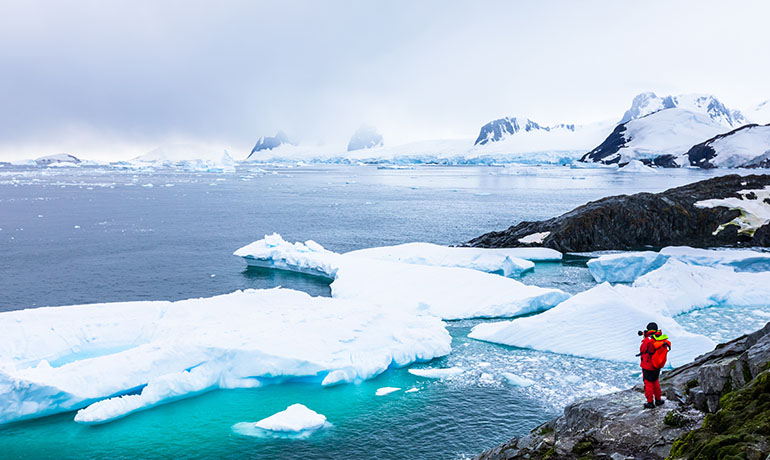
#1. Lounge With Penguins
Penguins thrive in cold climates, making Antarctica the perfect location to see them in their natural habitats. You’ll encounter five penguin species, including the King Penguin, Emperor Penguin, Rockhopper, and Adélie Penguins, which can be seen playing, mating, and leaping onto the Antarctica coast. If you’re lucky, baby penguins will approach you and pose for photos.
#2. Take A “Polar Plunge”
Stepping foot onto the Antarctica continent is a bucket list item for many people, while others want a more immersive experience like jumping into the water. Antarctica expedition cruises plan a ‘Polar Plunge’ to truly get a sense of the frigid water temperatures.
#3. Visit Deception Island
Explore Antarctica’s historical heritage by visiting Deception Island. This island has many remnants of its past as a whaling station used during the late 1960s. Go snowshoeing across the pack ice to see what was left behind.
#4. Kayak Through The Antarctic Peninsula Waterways
Massive glaciers reveal the true scale of the artic wonders in Antarctica as seen as you explore the Antarctic Peninsula Waterways via kayak. Bundle up as you navigate the icy waters where you might get a chance to see whales breaching the surface nearby.
#5. Photograph Icebergs
Even with most of their mass below the water surface, icebergs in Antarctica still tower 100+ feet above you. Seeing these giant ice blocks is surreal as you try to capture their awe-striking appearance on camera.
#6. Mail A Letter From Port Lockroy Post Office
Need proof that you’ve visited Antarctica? The Port Lockroy Post Office will gladly send your postcard to friends and family, which includes a unique stamp. In addition, the local penguins outside always make great photos to include with your mail.
#7. Cross The Infamous Drake Passage
The Pacific and Atlantic Oceans meet at the Drake Passage. Board your Antarctic cruise ship in Ushuaia, Argentina, and set off across the passage to reach one of the closest Antarctica landing sites. The Antarctica summer season is the best time to navigate the deep waters that are much more calm and manageable for tourist travel.
#8. Sail Through The Lemaire Channel
Towering glaciers rise on either side of you as you cruise through the narrow Lemaire channel. Many Antarctica excursions sail this popular route, where you’ll see glacial landmarks like the famous ‘Twin Towers.’
#9. Go Whale Spotting
Antarctica is a playground for the world’s largest mammals. Blue whales, minke whales, orcas, and humpback whales are a few common sightings while whale watching the Antarctic waters.
#10. Visit An Arctic Research Station
Antarctica is a frozen frontier full of mysteries waiting to be explored. The continent’s residents are a mix of scientists, biologists, ecologists, and other personnel helping document the arctic wonders. You’ll get a chance to peek into the operations with tour stops at local arctic stations.
#11. Visit “Blood Falls”
Antarctica blood falls. Unique red waterfall. Flowing from Taylor Glacier. Sightseeing in Antarctica includes stops at unusual landmarks like the “Blood Falls.” Iron minerals in the waters flowing from Taylor Glacier resemble blood falling five stories into the frozen West Lake Bonney.
#12. Explore The Coast In A Zodiac Boat
Large cruise ships do most of the heavy lifting to cross the rough waters of the Drake Passage to reach Antarctica. However, the inflatable Zodiac boats will finish the job to take you to the shore, where you’ll get the experience of a lifetime by stepping foot onto the ice-covered continent.
#13. Warm-Up In A Thermal Pool
Antarctica seems like the last place where you’d find an active volcano, but Deception Island once again surprises those who visit it. If the outdoor temperatures are warm enough, tourists are invited to go for a dip in the island’s thermal pools heated by Mount Erebus sitting below the surface.
The Bottom Line
While many destinations around the world experience peak travel seasons or even overtourism, tourism in Antarctica is still in its early stages. Set off on a journey to one of the most unique places on Earth and experience the beauty that nature can create when undisturbed.
There is only a six-month window to enjoy the ideal Antarctica Summer, where you’ll be immersed in the continent’s nature and wildlife. Our Marchay members have access to excursions that are both adventurous, educational, and full of surprises that you can only experience in Antarctica.
Find out more about how you can take this life-fulfilling journey to Earth’s last frontier.
Frequently Asked Questions
What is the warmest month in Antarctica?
Did you know that Antarctica doesn’t always have temperatures below freezing level? This comes as a surprise to travelers while planning a trip to Antarctica because of its location. Most of Antarctica lies below the Antarctic Circle, giving it a unique climate throughout the year.
The Antarctica Summer happens from October to March. This six-month season is when the South Pole continuously faces the sun, giving it a 24-hour daylight phenomenon. The constant sunlight warms up the frozen continent and melts the ice.
The warmest month in Antarctica occurs in January, in the middle of the summer, and one of the best months to visit. It’s when the sun has had time to deliver heat and sunlight to the once frozen continent. Temperatures in January can reach upwards of 50ºF (10ºF). With these temperatures, you can stand outdoors without a jacket and even see Antarctica wildflowers growing.
When is the best time to see penguins?
Witnessing the abundance of wildlife is one of the most exciting parts of visiting Antarctica. One of the most endearing residents of the continent is penguins. Large penguin rookeries can be found on the Antarctica mainland, the South Shetland Islands, swimming in the Weddell Sea, on the coastal reserve of the Ross Sea, and in other locations.
Antarctica is home to five species of penguins since it provides the optimal environment for them to live in. The best time to see penguins is during the Antarctic Summer. They are present all season but are active in different ways each month.
At the start of the summer, in late October and November, penguins are active during their mating season. By the end of the season, you can see penguin chicks waddling across the ice sheets and diving into the water.
Tourists are advised to keep their distance from the penguin colonies to not disturb their natural state. However, you might get lucky and be approached by the penguins, who are always happy to welcome visitors.
